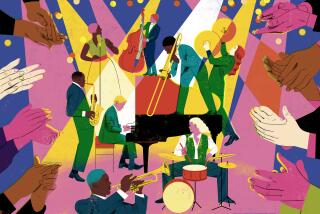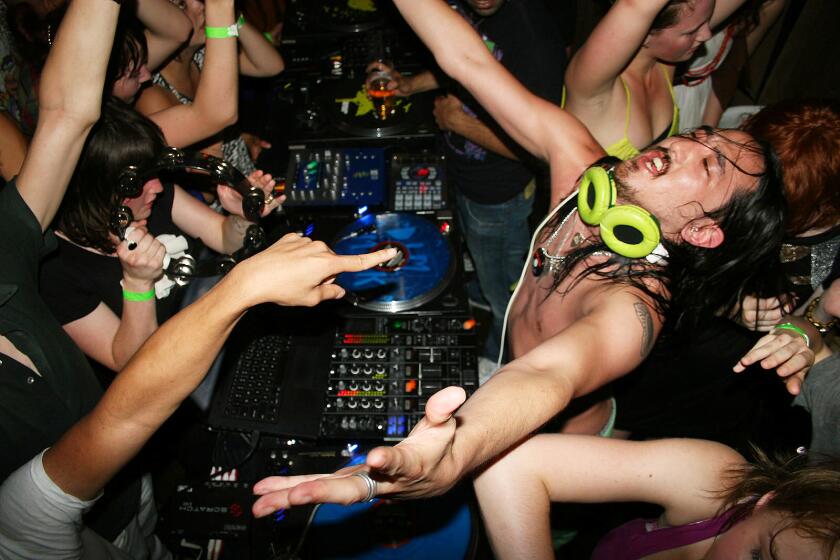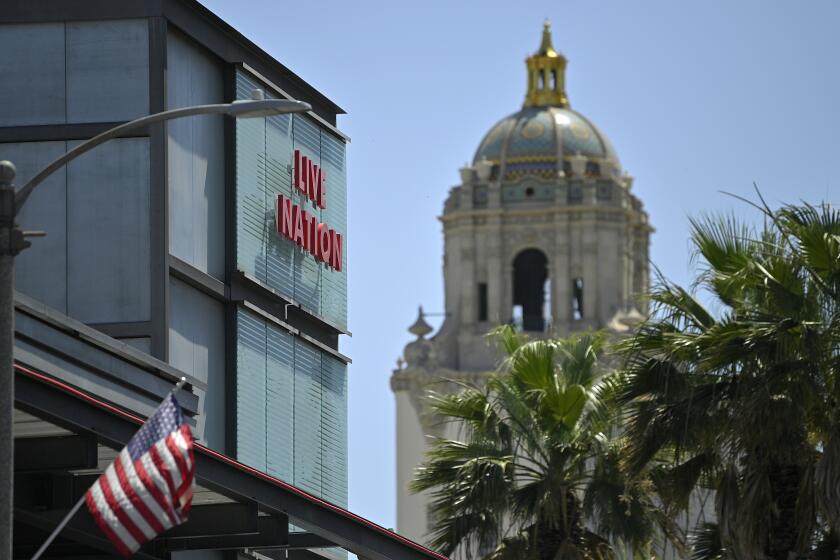Stan Getz, Master of Jazz Saxophone, Dead at 64
- Share via
Jazz saxophonist Stan Getz, who set off the bossa nova rage of the early 1960s, reviving a career that was almost shattered by drugs a decade earlier, died at his Malibu home Thursday.
The noted 64-year-old musician had been in and out of St. John’s Hospital and Health Center in Santa Monica for treatment in a battle with liver cancer over about five years, his son Steve said.
In September, 1987, when Getz learned he would have to undergo surgery to remove a large growth in his chest and would be forced to skip the second annual Palo Alto Jazz Festival, the musician was as cool as he always seemed to be on stage.
“I feel no resentment that this has happened to me, because this has been an era of rejuvenation of my music,” the tenor saxophonist said. “I don’t think God is finished with me yet. He wants me here on Earth another 20 years, and I’m all for it.”
At the time, Getz was an artist in residence at Stanford University and had performed a week earlier in a concert to raise money for the university’s jazz studies program.
With his feather-light, seemingly effortless tenor style, Getz had been a major jazz figure almost from the beginning as a teen-age sideman with various big swing bands in the 1940s.
Getz, however, seemed doomed by a destructive heroin habit that led him to jail and a near-fatal overdose. But he fought off the addiction and, in the early 1960s, returned from living in Denmark to record “Desafinado,” the tune that revived his career, enriched him and launched the bossa nova fad in the United States.
He soon recorded an even bigger bossa nova hit, “The Girl From Ipanema,” with Brazilian singer Astrud Gilberto. It won a Grammy Award for best record of the year, a first for a jazz performance. His “Jazz Samba” album, with guitarist Charlie Byrd, made his comeback complete.
From there on, Getz rarely performed without hearing requests for “Desafinado,” “One Note Samba,” “Corcovado” (quiet nights and quiet stars . . . ) or one of his other bossa nova hits.
He called bossa nova “a great hybrid, the true samba blended with cool jazz” and said it “is just like a man and a woman getting together.”
Getz was born in Philadelphia on Feb. 2, 1927, the son of a tailor and his wife who had shortened their name from Gayetzsky when they immigrated from Russia. The family moved to the Bronx, where young Getz played the bass and bassoon before finally settling on the tenor saxophone.
At 15, he appeared with both the Bronx All-City Orchestra and a band headed by Dick (Stinky) Rogers. Although his high school bandmaster recommended him for a Juilliard School scholarship, Getz quit school and took to the road with Jack Teagarden’s orchestra.
Getz was a disciple of the great black tenor man, Lester Young, but developed his own warm, easy style. He went from band to band, including those of Bob Chester, Stan Kenton, Jimmy Dorsey, Benny Goodman, Randy Brooks, Buddy Morrow and Herbie Fields.
He was 20 when he organized the Four Brothers saxophone team that gave Woody Herman’s Second Herd its distinctive sound. His solo on Herman’s “Early Autumn” album brought him national attention. After two years with Herman, Getz formed his own quartet and subsequently a quintet. By then he was famous as a master of the cool tenor saxophone sound.
A heroin addict since he was 18, Getz hit bottom in 1954, when he was arrested in a bumbling effort to hold up a Seattle pharmacy. Hours later, he was found unconscious in his cell. His condition was diagnosed as acute heroin intoxication. Some accounts suggested that Getz had attempted to kill himself.
Although the armed robbery charge was reduced to addiction, he returned to Los Angeles to face sentencing for addiction in a separate case. The judge observed that investigators had found Getz’s pregnant wife, Beverly, and their two children sleeping on mattresses on the floor of their Laurel Canyon house while the saxophonist was earning $1,000 a week.
The judge called Getz “a poor excuse for a man” and declared that it was time he “grew up.”
Getz said later he had already made up his mind to get off drugs and clean up his life. He noted that many musicians had been addicted to heroin during that period. He told a Newsday reporter: “None of us knew what we were getting into, what a messy scene it was. We were very young and working hard, staying up all night and looking for false stimulation of one kind or another. So many of us got caught up in this round-robin thing that ends in death or insanity.”
After six months in jail, Getz took up his saxophone again. He appeared as a sideman in the 1956 film, “The Benny Goodman Story.”
On vacation in Sweden, he came down with pneumonia and pleurisy that kept him hospitalized for eight months. Divorced from his first wife, he married Monica Silfveskiold (whom he had met earlier while she was studying in the United States) during that period and resumed his musical career. Getz drew praise from jazz critics and made numerous recordings and appearances.
While on a Norman Granz Jazz-at-the-Philharmonic tour of Europe, Getz decided to live in Denmark. He and his wife stayed there for three years. When he returned to the United States in 1961, it was to find bossa nova and enduring fame as he recorded with Brazilians Antonio Carlos Jobim, guitarist Joao Gilberto and the latter’s wife, Astrud.
He did not allow the Latin beat to keep him away from pure jazz, however, continuing to lead his own quartet and to record with such other highly regarded musicians as Count Basie, Oscar Peterson and Bob Brookmeyer.
In addition to his constant appearances at clubs and jazz concerts, he began in 1981 teaching during summers at Stanford, where he experimented with producing jazz by computer.
“I think jazz music is mostly a black man’s art,” he once told Times jazz critic Leonard Feather. “But there happen to be a few whites who can play it just as well, just as originally as any black man. Not many, but I know I’m one of them.”
And, he told Feather: “I want to be remembered for anything I’ve done. I’m lucky to be a part of jazz. It has enabled me to travel all over the world; it has contributed to my wisdom. I’m proud to be a part of this music, and by the same token I want my children and my grandchildren to be proud of me.”
Getz, who was divorced, leaves five children--Steven, David and Beverly from his first marriage, and Pamela and Nicholas from his second.
More to Read
The biggest entertainment stories
Get our big stories about Hollywood, film, television, music, arts, culture and more right in your inbox as soon as they publish.
You may occasionally receive promotional content from the Los Angeles Times.










